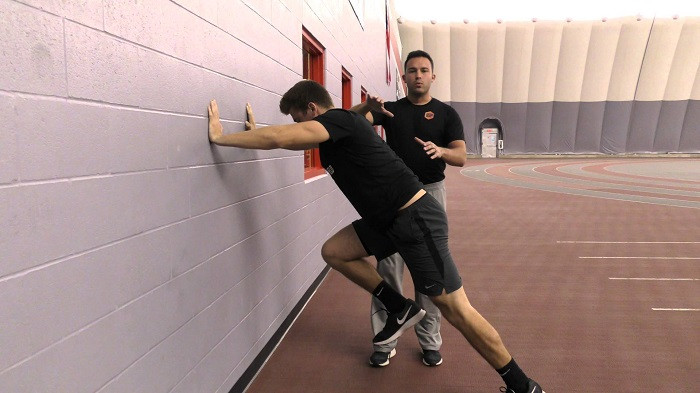How to run faster: drills and workouts to speed you up
A beginner’s path in running is pretty simple — start running, maintain the schedule, work on endurance, increase mileage and so on. But what comes next? When you decide you had enough dangling after every competitor on a race, there’s only one thing to focus on — speed.
Some suggest that running speed depends on many factors, like balanced diet, hydration, enough sleep etc. While these factors are important to respect, they are more about overall running experience. When it comes to running fast, there are only 3 things that truly improve your speed:
- Length of a stride
- Strength of the legs
- And a stride rate
Working on these key factors will make you a faster runner and improve your race time to a large degree.
Start with running form
Before moving to specific exercises that boost your speed, you should really look into developing a proper running form. It is a long-term investment that will pay off in terms of prolonged, injury free running. But surprisingly, it is also a general way to become a faster runner, because it embraces two key factors of running speed — rate and length of a stride.
One of the aspects of running form that affects speed is falling forward. It is invariable element of a stride when you literally start falling, which drives you forward. It generates greater momentum than your muscles could ever do. The maximum angle of falling is 22.5°.

There’s simple way to get used to leaning forward on a run. Stay tall, feet at the hips distance apart, lean forward from your ankles with your body in one long line until you start falling down. When start losing a balance, take a step forward.
A good exercise to maintain the balance while leaning is Superman pose, which we’ll talk about later.
Also, proper form means running efficiently. Running tall and relaxed, looking forward, swinging arms properly saves a lot of energy. And you can use that energy to run longer or to run faster. So, once you improved your mileage, you can put the energy into speed and improve a race time.
Strength training
It is obvious that a runner must have powerful legs and strong core. But how does it actually affect running speed?
Research done by Sports Performance Research Institute shows that sprinters with stronger legs are faster. They apply more force to the ground with each step and propel themselves forward further and faster.
Core muscles, for their part, provide stabilization to maintain balance, especially while accelerating. It means strength training should go hand in hand with regular running exercises.
But regular squats and lunges don’t do much. Runners should focus on exercises that increase explosive power during push-off. These exercises are more specific, but there are many to choose from.
Leg strength exercises
One of the best exercises for acceleration speed is sprints against the wall. It simulates the same movements of the regular sprint, but the force is applied to the ground and wall which creates more resistance and tension for your legs.
To do this exercise, you just need to stand against a wall, preferably outside. Place hands on a wall at shoulder height in a pushup position. Lean in until your body is at a 45-degree angle; bring one knee up to your chest in a starter position and then quickly "run" by alternating legs as if trying to run through the wall. Do it for 10-20 seconds, then rest for 10 seconds; 10 sets should be enough.
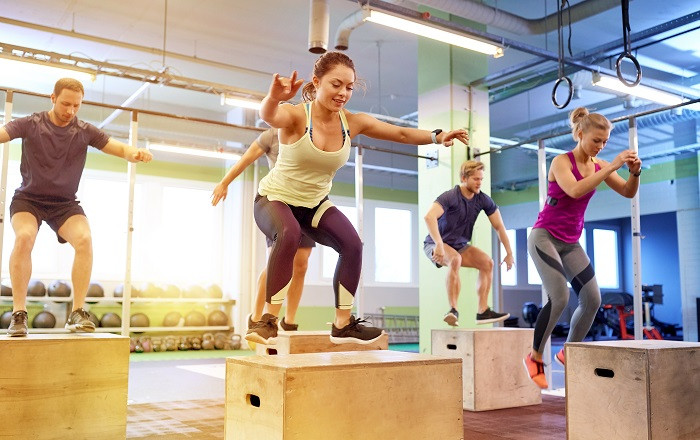
Another good exercise for explosive power is box jumping. For this drill you need a stable surface — preferably a plyometric box 30-90 centimeters (12-36 inches) high. Start with the lower one and increase its height as you progress.
Stand at a comfortable distance from the box, feet at a shoulder-width apart. Start the box jump by quickly getting into a quarter squat while hinging at the hips to engage the hamstrings and glutes. Then, forcefully extend your hips, swing your arms, and jump on the box.
You should land in a squat position, softly, absorbing the impact. Hold it for 2-3 seconds, then stand tall, and step back down.

Lunge jumps are slightly different than the original exercise. Your legs should work like springs while running, and this drill focuses just on that. Start in a split stance position with your hands on your hips, your torso upright, and your knees bent at a 90-degree angle. Push your chest out and lower your rear knee toward the ground in a lunge while keeping your front shin as vertical as possible.
Push explosively off the ground, jumping and switching the position of your legs while in mid-air, landing into the lunge position with the opposite leg forward. Repeat, switching legs on each jump.
Core strength exercises
Let’s start with classics — planking There’s many ways to do this exercise, but you can stick only to standard and side plank.
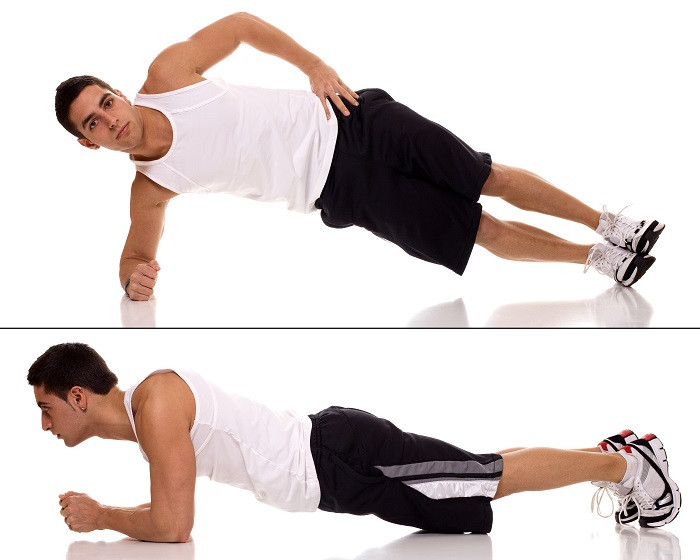
To do a standard plank, prop your weight on forearms and toes, face looking forward. Keep a straight line from the head to your feet; maintain this position for about a minute or more if you can.
Side plank is very similar to a standard one. Lay on a side, lift your body so a weight is resting on a side of a foot and one forearm. Keep a straight diagonal line from the head to your feet. Again, keep it up for about a minute or more if you’re able to.
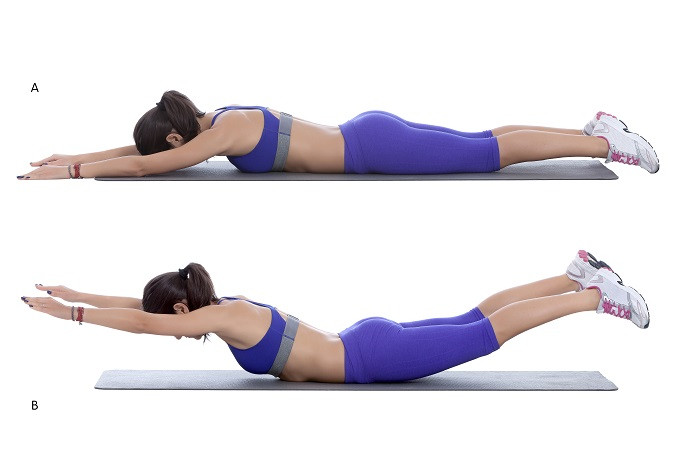
The Superman pose — lie face down, raise one arm off the ground and hold it for 20-30 seconds. Then release and raise the other arm. Repeat it for several times, then do exactly the same with your legs. As you advance, try holding an alternate leg and arm off the ground at the same time. Repeat it several times and relax. The most advanced version of this drill is holding both arms and legs off the ground at one time.
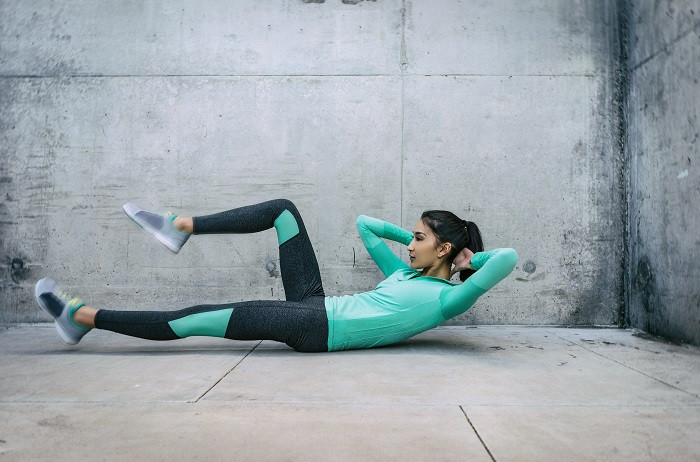
Modified bicycle is a more fun exercise to do. Lie on your back, hold one leg in the air, bent at 90° in the knee, so your shin is parallel to the ground. Hold your other leg straight and a little bit off the ground. Then simply change your legs, as you were riding a bike. Hold still in each position for about a second, so your movements are soft and smooth.
Speed workouts
Working on your strength and cadence doesn’t make you faster by itself. It’s just an opportunity to work on and improve your speed.
Strides. Many runners use this drill as a recovery after a regular run, but this is a nice way to introduce yourself to faster running. To do this exercise, gradually accelerate to about 95% of your max speed, keep it up for 2-3 seconds, then reduce your speed to full stop and rest. Do it for 4-6 times.
Intervals. This is something similar to strides, but for a longer periods of time. Best performed on a track, this exercise help you get used to longer bursts of speed with a bit less recovery.
On the straightaways of the track run a little faster than your comfortable pace, and at the curves slow down or even walk, if you feel that way. Don’t sprint, you will gradually increase your speed as you progress.
If you’re unable to find a track, this drill may be performed even on a manual treadmill, you just need to establish time or distance measurements that will display intervals. For example, you can run on a street — one block fast, then one block slow to recover.
Fartlek. A great exercise to improve overall speed. This is also intervals of high-energy bursts followed by recovery. But they are somewhat different and fun to do.
Up to its name, classic fartlek (“speed play” in Swedish) blends a continuous running with speed intervals. Basically, it’s bursts of mid to high speed intervals for undetermined periods of time or distance. And, unlike many speed workouts, during recovery phase you continue to run at the regular pace or slower, which keeps heart rate high up.
Hill workouts
Training on hills is probably the best way increase speed, because:
- it builds muscle strength, because running uphill is naturally harder;
- improves running form, since you need to place your foot higher, you stretch glutes and hips better;
- improves your endurance;
Benefits of hill workouts were scientifically proved. For example, a study done by Derek Ferley, Ph.D., showed that a group of runners, that did hill training twice a week for 6 weeks had their top speed boosted and were able to sustain it 32% longer, compared to groups without hill exercising.
As you can see, hill workouts are essential and, combined with other exercises, can improve your running speed drastically.
There are different kinds of hill workouts, depending on what is your goal. If you want to simply run faster on the road, you should choose a hill sprints. Sprint on a hill at about 5-10% incline for 30 seconds, at the max speed. Then rest with a walk or an easy jog for 2 to 3 minutes in between. Start with 5 to 8 repetitions and work your way up to 12 to 14.
If you are preparing for a long hilly run, longer hill repeats are the way to go. Lengthier ascent prepares you better mentally for more-technical courses, Ferley says.
It’s basically the same exercise, with a difference that you run for 3 minutes at about 70% of your maximum speed.Then rest with a walk for 3 minutes until your heart rate drops. Start with 2-3 repetitions and advance to 6.
If you want to crush hilly course, warm up for 2 to 3 easy miles, then do 6 to 8 one minute hill repetitions at a 4% to 5% grade. Jog downhill for the recovery. Take 1 mile easy (more advanced runners can skip this step) then run 1 to 3 miles at goal race pace before a 1-mile cooldown.
Lose weight
Doing specific exercises is not the only way to speed up your race time. It is a no-brainer — the less you weigh, the faster you go. It applies to any weight, not only your body mass. So if you’re aiming for the best result, don’t overload on unnecessary gear.
For every pound lost, a runner speeds up for about 2 seconds per mile (1 kilogram lost results in -3 seconds per kilometer). This effect actually multiplies over distance, so a loss of 10 pounds (4.5 kilograms) would result in saving a whole minute in a 5k race, and translated to the marathon distance, it is almost 9 minutes of time saved.
So consider running to lose weight if you want a PB on the next race.
Rest
Another option, that is not directly related to exercising. Running everyday and pushing yourself too much won’t make you any faster. Overtraining is as bad as being lazy bone and skipping workouts. But a proper training regimen requires to have rest days, because it’s during this time your body is able to repair and rebuild muscle and strengthen tendons and ligaments. So make sure you give your body at least one day off per week.
Conclusions
To become a faster runner, there’s a lot things to improve. Start with your form; learning to lean forward is the solid ground to work on the speed. Implement speed workouts, such as intervals, strides, or fartlek. Hill workouts can also come to use. And don’t forget about regular drills to strengthen core muscles and gain explosive power.
